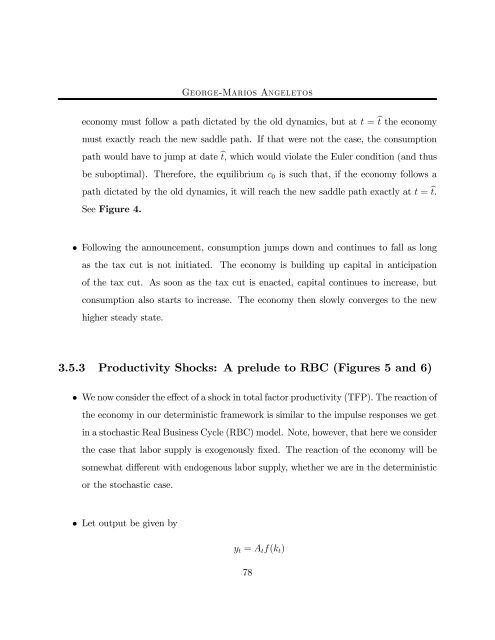14.451 Lecture Notes Economic Growth
14.451 Lecture Notes Economic Growth
14.451 Lecture Notes Economic Growth
Create successful ePaper yourself
Turn your PDF publications into a flip-book with our unique Google optimized e-Paper software.
George-Marios Angeletos<br />
economy must follow a path dictated by the old dynamics, but at t = bt the economy<br />
must exactly reach the new saddle path. If that were not the case, the consumption<br />
path would have to jump at date bt, which would violate the Euler condition (and thus<br />
be suboptimal). Therefore, the equilibrium c0 is such that, if the economy follows a<br />
path dictated by the old dynamics, it will reach the new saddle path exactly at t = bt.<br />
See Figure 4.<br />
• Following the announcement, consumption jumps down and continues to fall as long<br />
as the tax cut is not initiated. The economy is building up capital in anticipation<br />
of the tax cut. As soon as the tax cut is enacted, capital continues to increase, but<br />
consumption also starts to increase. The economy then slowly converges to the new<br />
higher steady state.<br />
3.5.3 Productivity Shocks: A prelude to RBC (Figures 5 and 6)<br />
• We now consider the effect of a shock in total factor productivity (TFP). The reaction of<br />
the economy in our deterministic framework is similar to the impulse responses we get<br />
in a stochastic Real Business Cycle (RBC) model. Note, however, that here we consider<br />
the case that labor supply is exogenously fixed. The reaction of the economy will be<br />
somewhat different with endogenous labor supply, whether we are in the deterministic<br />
or the stochastic case.<br />
• Let output be given by<br />
yt = Atf(kt)<br />
78

















